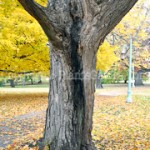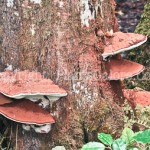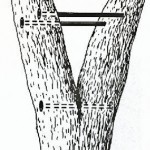 When trees grow tall and begin to tower over houses, garages and driveways, people often become concerned about whether they are a potential danger. Actually, there are a lot of situations when they should be concerned but are unaware of the possibilities. We have all seen the damage that a huge tree limb can cause when it comes down in a storm. Occasionally, people are injured or killed in such situations. How can we tell when a tree is going to come down?
When trees grow tall and begin to tower over houses, garages and driveways, people often become concerned about whether they are a potential danger. Actually, there are a lot of situations when they should be concerned but are unaware of the possibilities. We have all seen the damage that a huge tree limb can cause when it comes down in a storm. Occasionally, people are injured or killed in such situations. How can we tell when a tree is going to come down?
Unfortunately, the answer is that we can never be absolutely sure. Many factors enter into the determination of the safety of a tree. In most cases, we can only come up with an increased or decreased probability that a tree or limb will fall. Then you have to make a decision based on how much risk you are willing to accept.
 The first factor to consider is the type of tree involved. Certain “fast growing” species have inherently weak or brittle wood and are more likely to come apart in a storm or under an ice load. Silver maple, elms, poplars, Russian olive, willow and many similar trees have the reputation of being “trashy trees.” This is because their brittle wood lends itself to coming apart in the wind.
The first factor to consider is the type of tree involved. Certain “fast growing” species have inherently weak or brittle wood and are more likely to come apart in a storm or under an ice load. Silver maple, elms, poplars, Russian olive, willow and many similar trees have the reputation of being “trashy trees.” This is because their brittle wood lends itself to coming apart in the wind.
Another major factor is the amount of rot in a tree. We have all seen trees with large hollow areas in the main trunk. These trees are still alive and growing and may be this way for decades. However, they are certainly not as strong as they would be if the rot had not taken place. Trees have the ability to grow around the rot so that it is hidden from view. Often the rot is not discovered until the tree falls and it is being cut up for firewood.
 External signs of rot on a tree often indicate serious trouble. So-called platform or shelf fungi growing out at the base of the tree is usually a very serious sign of root rot. This is commonly seen on large oaks and usually means the tree is not as stable as it once may have been. When the roots on one side rot away, the tree has lost a valuable anchor and may be pushed over by a storm.
External signs of rot on a tree often indicate serious trouble. So-called platform or shelf fungi growing out at the base of the tree is usually a very serious sign of root rot. This is commonly seen on large oaks and usually means the tree is not as stable as it once may have been. When the roots on one side rot away, the tree has lost a valuable anchor and may be pushed over by a storm.
Hollow stems and trunks also indicate a weakness in the tree. These are the result of rots or diseases called cankers which kill the bark and the cambium layer beneath it. Again, these trees may go about their merry way for years and all we can say is that there is an increased possibility that they may break off.
 What can we do about these things? The range of alternatives is somewhat limited. In the extreme, if multiple factors add up to a very high probability that a tree or branch will fall on a structure or where people are likely to be, we can cut them down. Of course, this eliminates the threat but it also eliminates a tree that might have taken 100 years to grow. Still, no tree is worth the life or injury of even one person.
What can we do about these things? The range of alternatives is somewhat limited. In the extreme, if multiple factors add up to a very high probability that a tree or branch will fall on a structure or where people are likely to be, we can cut them down. Of course, this eliminates the threat but it also eliminates a tree that might have taken 100 years to grow. Still, no tree is worth the life or injury of even one person.
A second step would be to try to reduce the threat. A branch may be attached to the main trunk by a cable or metal rod to help stabilize it. The success of this rests on the strength of the main trunk too. In some cases, the canopy of the tree may be pruned to balance off the load of branches and foliage. Major branches may be removed to bring the canopy into alignment.
 One technique that should be avoided is the old practice of “topping off” a tree. One way people used to keep trees to a desired size was just to climb up and cut them off at a certain height. In essence, they would give the tree a “flat top” haircut. This not only makes the tree look extremely ugly during the winter but it encourages a “witches broom” effect on the top of the pruned branches. The resulting growth in a few years is actually weaker and more likely to fall apart that the original growth.
One technique that should be avoided is the old practice of “topping off” a tree. One way people used to keep trees to a desired size was just to climb up and cut them off at a certain height. In essence, they would give the tree a “flat top” haircut. This not only makes the tree look extremely ugly during the winter but it encourages a “witches broom” effect on the top of the pruned branches. The resulting growth in a few years is actually weaker and more likely to fall apart that the original growth.
In the end, you may need to hire a professional arborist to evaluate your trees. These people are usually highly trained and, in most states, they may actually be licensed. They can perform certain non-invasive tests on a tree to test its soundness. Many of them can tell a lot by tapping the tree with a mallet.
Also, if you decide to try using cables to help stabilize your tree, it is best to have a professional do it. They have the equipment and know how to get the best results. Even then,…there are no guarantees. Good luck.
